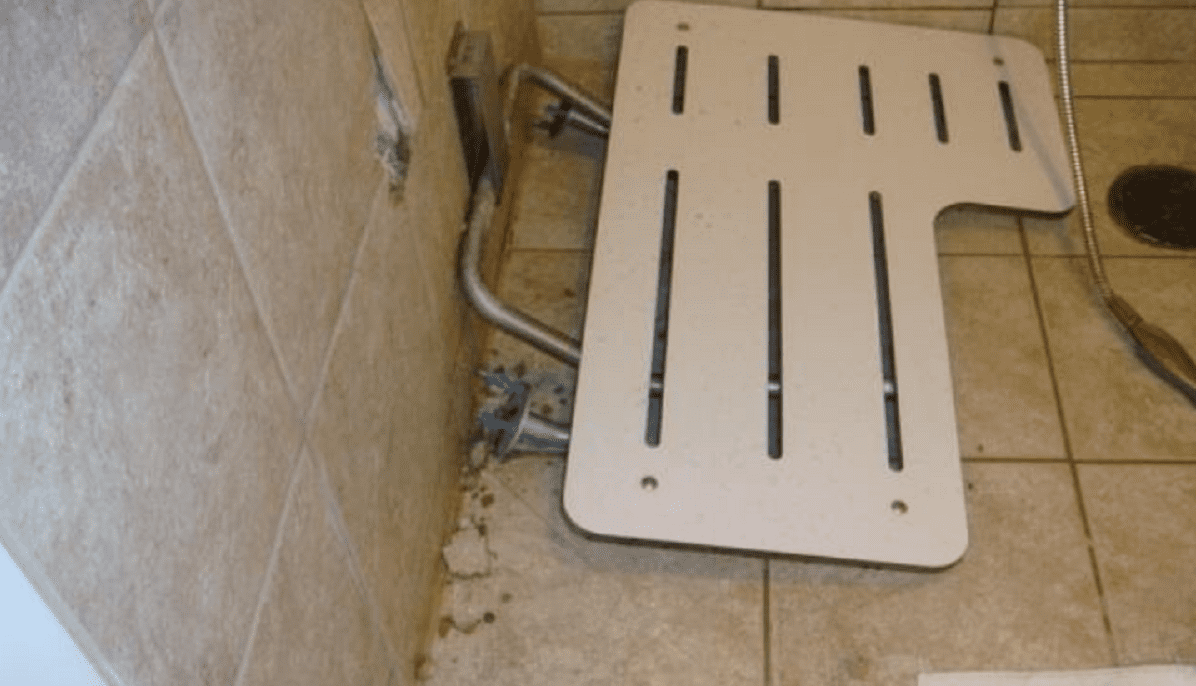ADA Shower Seat Collapse

,
John R. Yannaccone, P.E., Senior Mechanical Engineer
Case Synopsis: A hotel guest was taking a shower in a handicap accessible guest room. He was sitting on the wall-mounted shower seat when it collapsed, causing the guest to fall onto the floor of the shower. His wife contacted the front desk who sent hotel employees to assist her in helping her husband off the shower floor. Initially, the man reported he was uninjured but was later taken to an urgent care center when he indicated he was experiencing pain from his fall.
Expert Analysis: Photographs of the shower and shower seat, from the time of the incident, showed the upper portion of the shower seat had separated from the wall of the shower. Additionally, the photographs showed the support structure of the seat was still intact and appeared to be undamaged.
The specification for the shower seat indicated a maximum occupant weight of 360 pounds. Medical records for the plaintiff indicated he was between 260 and 270 pounds, which was well within the design limits. The instructions for the seat provided some guidance for installing the shower seat. The shower wall on which the shower seat was mounted was a hollow, studded wall. The manufacturer’s installation requirements for mounting to a studded wall indicated there had to be a backer board installed between the studs and that the seat itself had to be attached to the wall with #14 screws. Local building codes required a backer for shower seats capable of supporting the shower seat with a 250-pound occupant, as opposed to the allowable 360-pound occupant for which the subject shower seat was designed.
Photographs showed none of the mounting screws had failed and they appeared to be of adequate size. However, instead of being screwed into a backer board as specified in the installation instructions, the shower seat was attached to the wall using plastic hollow wall anchors. Several of the wall anchors pulled out of the wall, while in other locations, several screws pulled out of the anchor.
A destructive inspection of the wall revealed there was no backer installed in the shower wall of the subject room. Review of design drawings indicated that 2 x 4 backers were required between the studs in all ADA-accessible rooms but did not provide a clear indication of which rooms were included as accessible. Therefore, it was unclear if the subject room was originally intended to have a shower seat or if the shower seat was added at sometime after construction was completed.
The shower seat instructions also called for periodic inspections to verify it was securely mounted to the wall. There were no records of any such inspection taking place by hotel staff, and management was not familiar with any inspection requirements for the shower seat. Maintenance records for the hotel indicated repair work was performed on the shower seat in the incident room; however, neither a description of the problems, or repairs undertaken, were contained in the records.
Based on the physical evidence, the shower seat itself did not fail, rather the attachment of the shower seat to the wall was not sufficient to support the guest. The installation instructions do not provide sufficient requirements to assure adequate structure to support the allowable 360-pound occupant. However, it was not clear if the incident room was originally intended to have a shower seat installed and should have had support structure for the shower seat in the wall when the building was constructed. It was clear the hotel staff had addressed prior issues with the mounting of the shower seat in this room and attempted to make repairs. They failed to identify the improper mounting of the shower seat and also failed to perform periodic inspections of the seat as required.
Result: Prior to trial, a settlement was reached with all parties.
John R. Yannaccone, P.E., Senior Mechanical Engineer with DJS Associates, Inc., can be reached via email at experts@forensicDJS.com or via phone at 215-659-2010.
Tags: John R. Yannaccone | Mechanical Engineer


